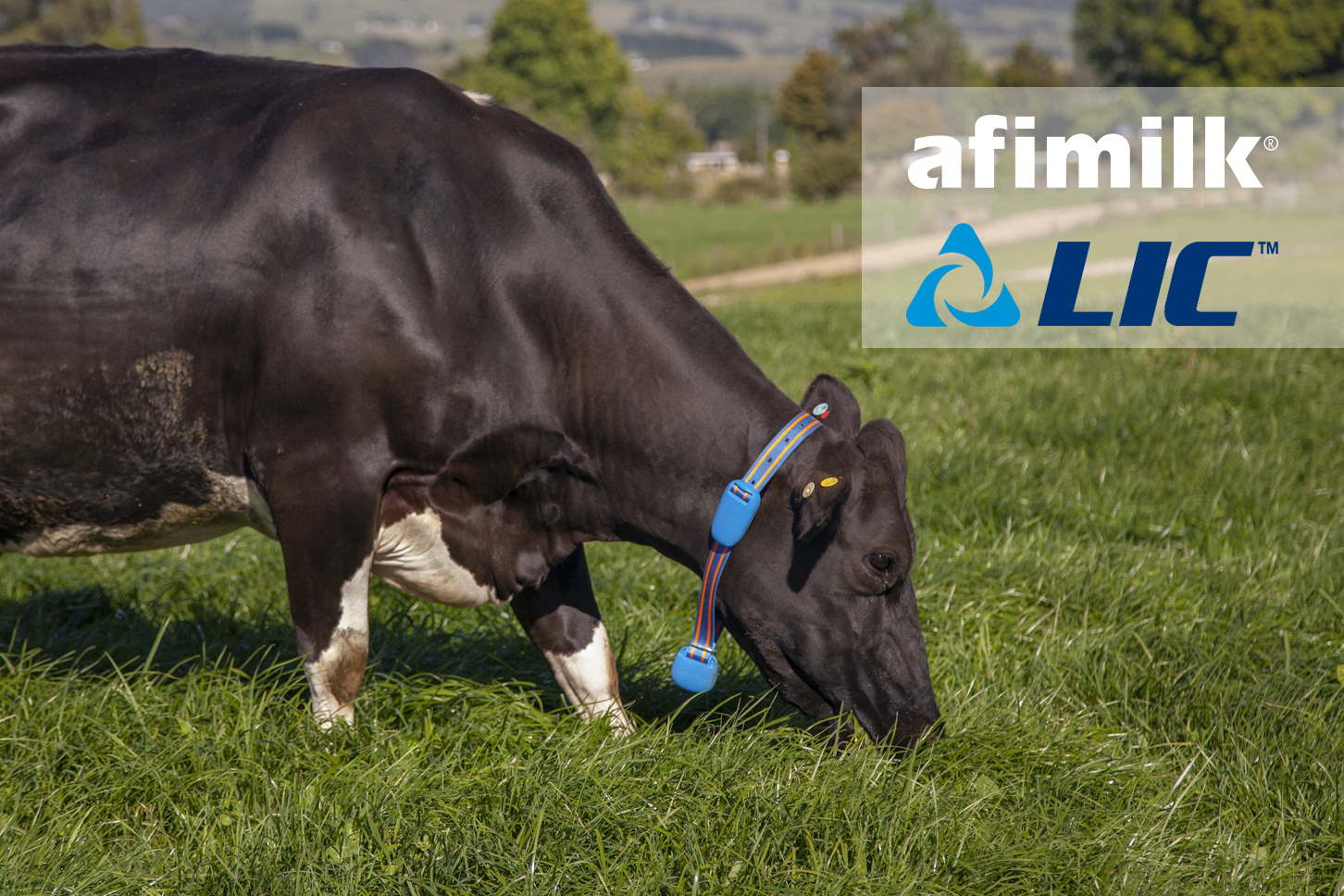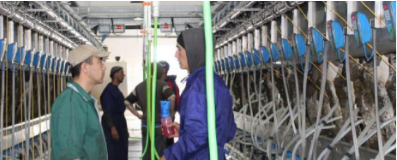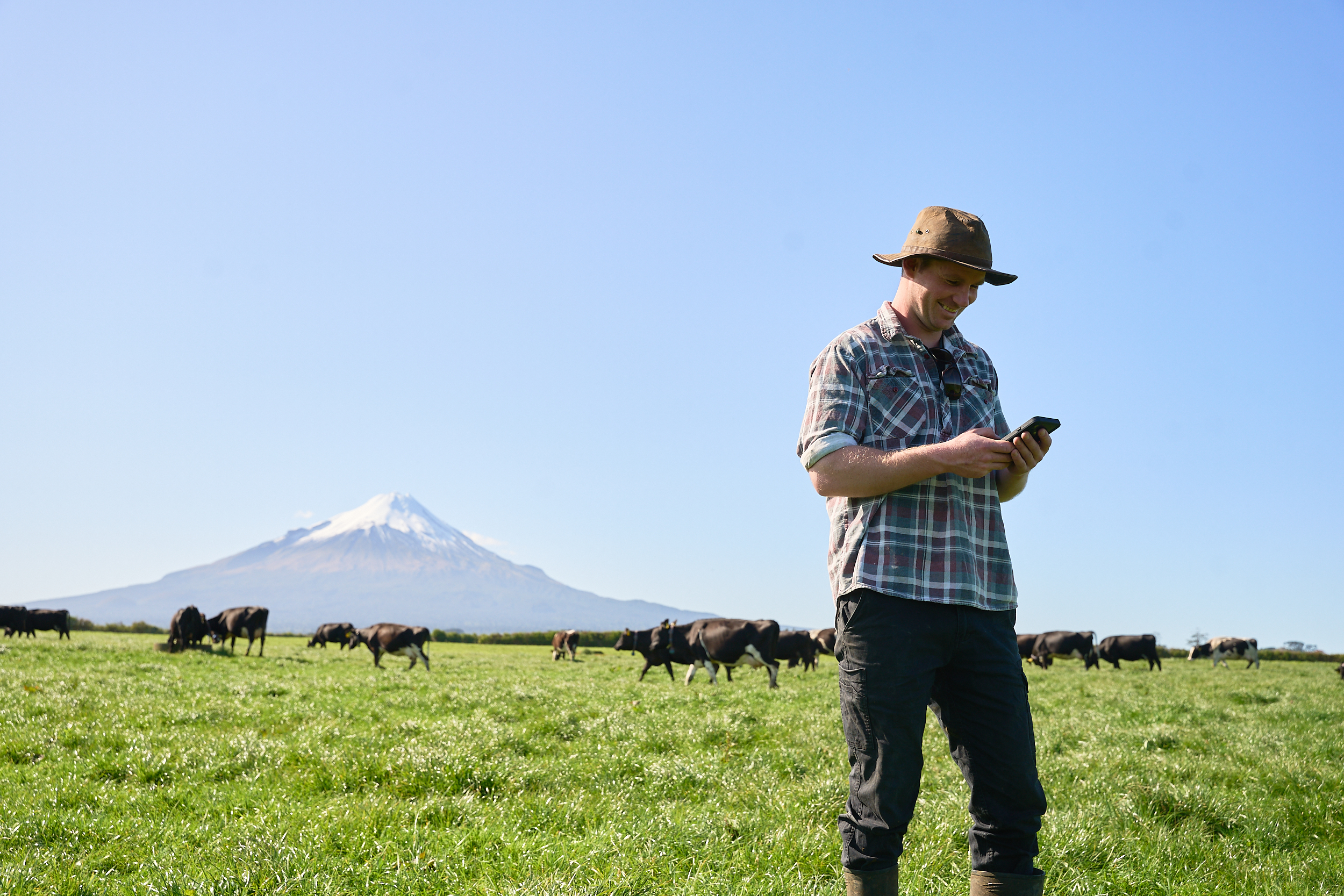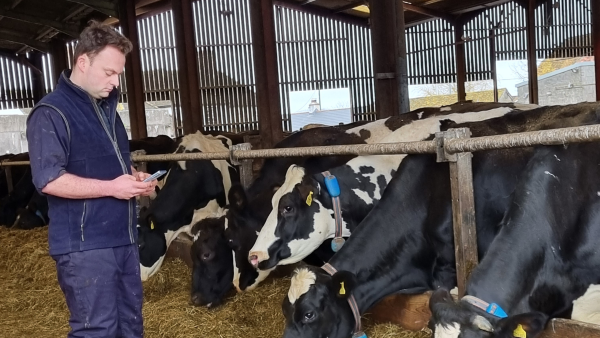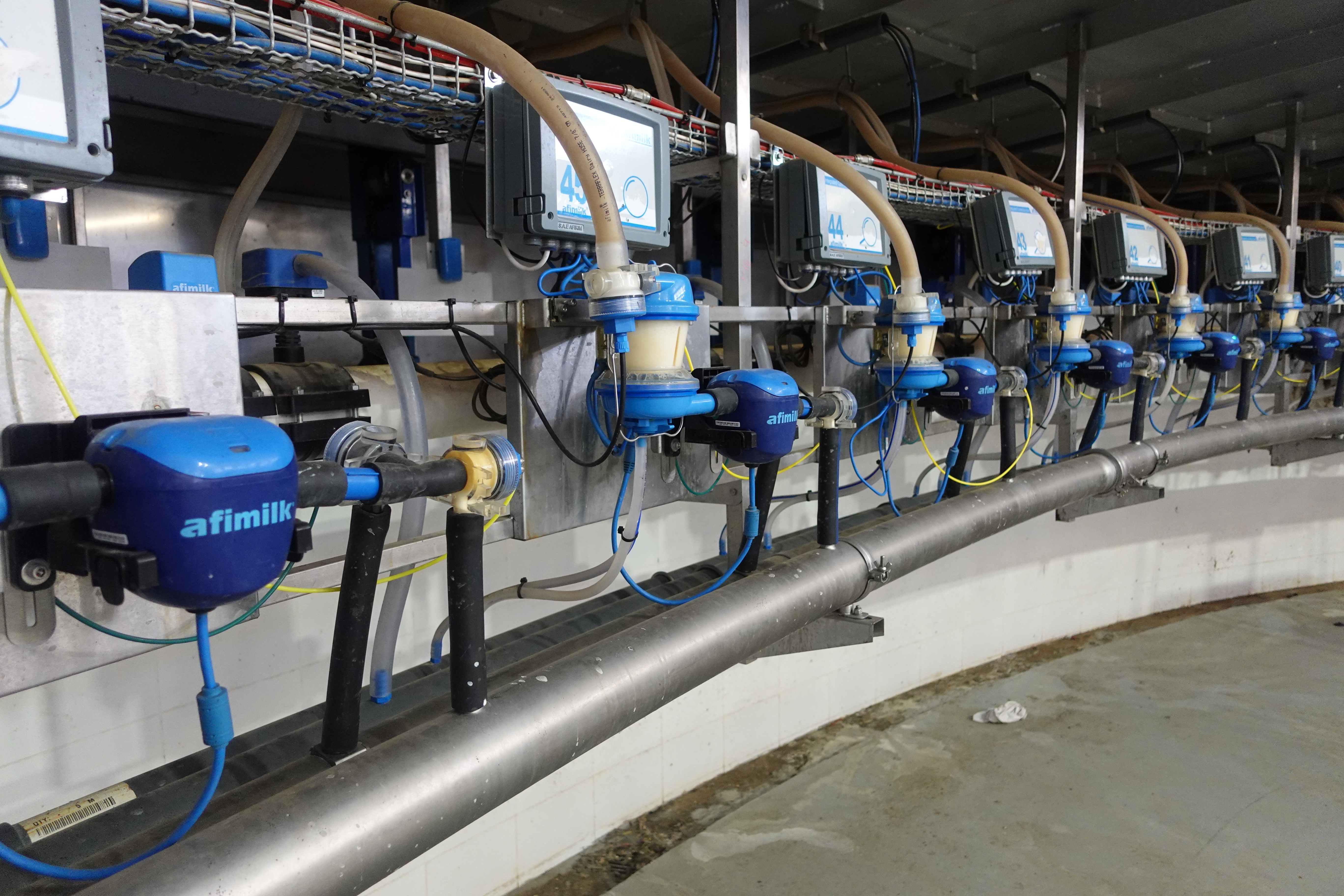Pinhas Gur, Afimilk, Israel
Each farmer’s goal is to have a cost effective program to grow out and inseminate his quality females to the bulls of his choice.
To achieve maximum genetic gains in a dairy herd, artificial insemination with top proven sires must be used on all cows and replacement heifers. The benefits of AI are clear, however AI is not without its problems, the primary one being heat detection.
Large scale independent research shows the clear advantages of the afimilk system. Experiments were conducted to assess the contribution of a computer system in the milking parlor to the detection of mastitis and estrous (udder infection and the time to inseminate the cow). It was found that the computer system contributed markedly to the cows’ productivity and profitability.
Only the heat detection part of the experiments is described in detail.
Introduction
This paper will describe the process of automatic heat detection and assess the benefits by comparing the performance of farms with computerized information systems to those without.
The economic implications of these modern developments are seldom quantified.
We report a direct measurement of the economic contribution of a computerized information system in dairy farms (the system that was installed was the afimilk system). An economic estimate of the contribution of the computerized information system is presented.
What is Estrous
Estrous is the period of heat. Accurate detection and consequent insemination increase the probability of timely and successful conception. Most cows in Estrous can be detected by visible symptoms: unrest, mounting and vaginal discharge. These cows are examined, inseminated if found to be in heat. Success was verified after 28 days by testing for progesterone in the milk.
Others may not display visible signs of heat – this is an anestrous condition. In these cases the cows are inspected by the veterinarian to determine estrous or the cause of its absence.
Unidentified estrous reduces the probability of timely insemination, increases the number of unintended and unproductive open days (days between calving) and may result in culling of high yielding cows.
Computer-supported activity-measurements are used for identification of estrous. Cows within the afimilk system wear foot tags with pedometers that identify them in the milking stall. The pedometers count steps per time unit, the numbers are transmitted to the information system and the hourly averages recorded. Deviations from each cow’s norm are marked as unrest, suspected estrous and possible ill health. The afimilk system installed in kibbutz Yavneh at the time of the study could indicate estrous in cows that had calved at least once, modern systems such as those described by Maatje et al. (1997) can detect estrous in calves before first calving as well (AfiAct Heifer System).
Problems with visual heat detection
A distinct advantage of afimilk automatic Heat Detection is the savings in labor costs usually involved in visual heat detection.
The Cornell University table and Dransfield chart show the problematic character of visual heat detection whereas the system performs monitoring 24 hours a day.
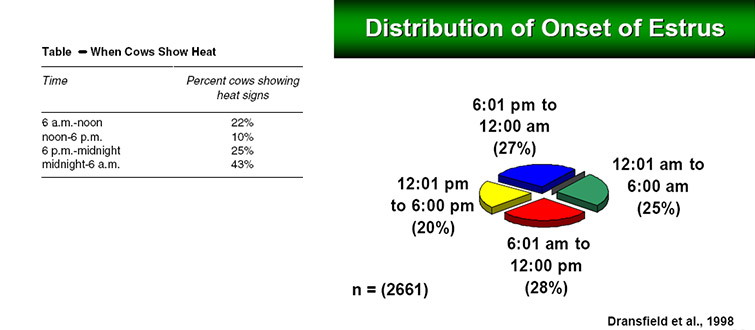
The afimilk System
afimilk is the trade name of the dairy parlor information system used in this study. It is produced and assembled in Israel. Such systems include a PC (AfiFarm Herd Management software) and electronic sensors which identify cows, monitor their production variables, keep records and provide management with information to assist in making feeding, health and reproduction decisions. afimilk was first introduced experimentally in 1986 and by now, more than 1.5 million afimilk pedometers are in use world wide.
afimilk performs the following functions:
- identifies cows in the milking stalls;
- monitors the cow’s milk flow and yield;
- measures electrical conductivity of milk and indicates suspected mastitis;
- records unrest and indicates estrous.
The system features, three times daily, irregularities, deviations and detection alerts. Data summaries are constantly on call as are specific reports – such as individual cow’s health and yield history. Parameters for significance levels of tests of deviations can be fine-tuned by season, group or cows’ conditions.
Comparison between visual detection, neck transponder and Afi Pedometer
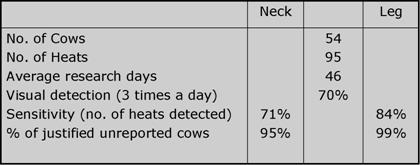
The experiment domain
The studies were conducted in Israel, Italy and Holland.
The milking cows were divided with the introduction of afimilk and the commencement of the study into trial groups and a control groups. The information provided by afimilk and used for mastitis and estrous detection was made available to the dairy operators only for the trial groups.
The information for the control group was blocked at source. Consequently, the herdsmen received only three yield measurements per day for the control cows, whereas additional 9 measurements were available for the cows in the trial group (steps per hour, rate of milk flow and electrical conductivity of the milk for each of the three milking sessions). Without this additional information the operators had to rely, in the control group, on conventional methods of mastitis and estrous detection. The cows from both groups were mixed in the cowsheds, group identity was masked and all cows were treated similarly.
The field studies lasted from 12 to 18 months. This period covered a full lactation period for all cows included in the study. Each cow’s milk yield and other parameters were measured and recorded three times a day.
The effect of estrous detection was measured in open days (the days between calving and confirmed conception). The contribution of the afimilk system was calculated as the value of the difference in milk production and average open days between the trial and the control groups of cows.
The division of the herds
The milking cows were divided into trial and control groups. Cows about to be culled were not included in the study. The selection was stratified by the following variables: lactation, calving related diseases, number of days from calving and projected milk yield. The stratification was lexicographic; that is, the cows were assigned into one of three categories by lactation – first, second or higher; each of these was divided again for calving related diseases – yes or no – thereby adding two categories for a total of 6. The assignment was then repeated within each category into an additional six categories by days counted from last calving. The process ended with the cows in each of these 36 strata being randomly divided between 303 cows in each group.
Mastitis Detection – (only the concluding tables)
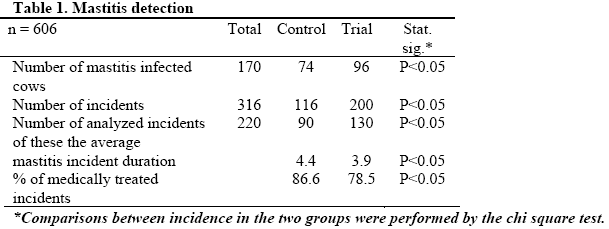

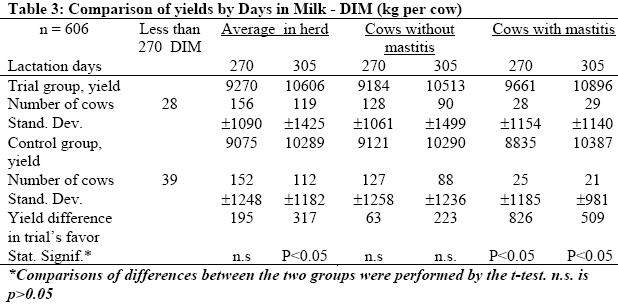
Estrous detection
Table 4 summarizes the major findings for the cows that fitted into the studies schedule and with pregnancies of less than 150 open days. Delayed impregnation – defined as
having more than 150 open days – is usually caused by problems unrelated to inaccurate estrous detection such as reproductive system malfunction and diet deficiency disorders. These pregnancies and the explanation of their greater open day differences are beyond the scope of this study.
Table 4: Efficiency of cow heat detection
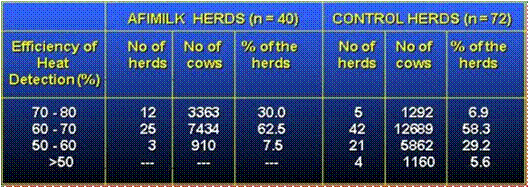
Table 5: Distribution of Cycles

Table 6: Reduction of Days Open after installation of the afimilk System We will use the more conservative figure of 14.7 Days Open for our calculations.

As the data in Table 6 indicates, there was a difference in Open Days between the trial and the control group. Cows in the trial group did better than those in the control group. We have also found, but not reported in Table 6, that the differences between the trial and the control groups increased with age. It is more difficult to detect estrous in older cows and the electronic devices therefore contribute more to estrous detection as the cows age.
Benefits and costs (including the Mastitis study data)
Computer detection reduced milk losses due to mastitis and open days of milking cows. The calculation of the benefits in our experiment was based on data prepared by the Extension Service of the Ministry of Agriculture converted to US dollars. The following parameters are current Israeli parameters.
- Gate price of 1 kg standard quality milk $0.36
- Marginal feed cost $0.10
- Marginal net value of 1 kg. milk $0.26
- Value of open day prevented $3.50
Table 7 reports the benefits per cow in the herd in Yavneh. Milk loss prevented, 248 kg, was calculated as the weighted average for yield difference in trial’s favor in Table 3 (for average in herd).
We did not calculate for:
- Discarded Milk
- Added labor and medicine costs for treatment of Mastitis cows.
- Cows with Mastitis treated 3 days earlier give 7% more milk during the lactation.
The number for average open days is from Table 6. The sum of benefits per cow is $115.23. The repayment period is approximately 2 years for a 300 cow herd.
Table 7: Gross benefits (average per trial cow)
| Measured Benefits | mesured Differences | |
|---|---|---|
| Prevented Milk Loss* | $64.48 = ($0.26*248) | 248 kg |
| Reduced Days Open | $50.75 = ($3.50*14.5) | 14.5 days |
| Total Benefits | $115.23 |
* Milk Loss calculations are from Yavneh Herd study – Tables 3 & 4
Concluding remarks
We have reported an experiment in one herd for mastitis and average values for many herds for heat detection. The findings clearly indicate a favorable cost-benefit ratio. Several comments are now in order.
The cost of the system – per cow – will be higher for smaller herds. The benefits, on the other hand, could increase with herd size because of the difficulty to recognize individual cows and monitor their particular problems. Kibbutz herds are relatively large. The benefit from such a system may be different for family farms with 30 – 50 cows.
The human factor is of great importance in livestock enterprises, and Yavneh, as indicated, has a dedicated group of workers – professional and motivated. It may well be that the contribution of the computer system would have been greater with an average team. Particularly, one may expect the share of the contribution of estrous identification to be larger in many other dairies. Also, it is often claimed that the benefits of a computer system should be attributed to improved management practices by teaching operators the significance of even minor nuances in livestock behavior and performance and reporting them. This component was probably only of minor importance in Yavneh and, still, as our findings indicate, the computer system contributed substantially to profitability of milk production in the kibbutz.
We attributed benefits only to losses prevented in milk and open days. These are not the only benefits; for example, early detection of mastitis and accurate identification of estrous may reduce culling of problematic, often high-yielding, cows. We similarly did not include in the benefits the prevention of discarded milk of mastitis infected cows, of additional labor needed for milking an infected udder by hand and the cost of medicine prevented.
REFERENCES
E. Gelb a, Y. Kislev b, H. Voet c
Center for Agricultural Economic Research, Rehovot Israel
Department of Agricultural Economics and Management, Faculty of Agriculture, Hebrew University, P.O.Box 12, Rehovot, Israel. <kislev@agri.huji.ac.il>; <voet@agri.huji.ac.il>
The Yavneh herdsmen and the advice of Y. Yahav, O. Makusfeld-Nir, A. Saran, A. Berman and E. Ezra and Barbara Kohn.
Allore, H., Jones, L., Merrill, W., and Oltenacu, P., 1995. A Decision Support System for
evaluating Mastitis information. Journal of Dairy Science, 78:1382 -1398.
Dijkhuizen, A. A., Huirne, R. B. M., Harsh, S. B. and Gardner, R. W., 1997. Economics of
robot application. Computers and Electronics in Agriculture, 17:111-121.
Frost, A. R., Schofield, C. P., Beaulah, S. A., Mottram, T. T., Lines, J. A. and Wathes, C. M.,
1997.
A review of livestock monitoring and the need for integrated systems. Computers and Electronics
in Agriculture, 17:139-159.
Geers, R., 1994. Electronic monitoring of farm animals: a review of research and
development requirements and expected benefits. Computers and Electronics in Agriculture,
10:1-9.
Houben, E., Dijkhuizen, A., Arendonk, J. and Huirne, R.B.M., 1993. Short and long term
production losses and repeatability of Clinical Mastitis in Dairy Cattle. Journal of Dairy Science,
76:2561-78.
Huirne, R.B.M., Harsh, S. B., Dijkhuizen, A.A., 1997. Critical Success Factors and Information needs on dairy farms: The Farmer’s opinion. Livestock Production Science, 48: 229-238.
Lazarus, W., Streeter, D. and Joffre-Giraudo, E., 1990. Management Information Systems: impact on dairy farm profitability. North Central Journal of Agricultural Economics, 2:267-277.
Lowenberg-DeBoer, J., 1996. Precision Farming and the new Information Technology:
Implications for farm management, Policy, and Research: Discussion. American Journal of Agricultural Economics, 78:1281 -1284.
Lucy, S. and Rowlands, G., 1994. The association between clinical mastitis and milk yield in dairy cows. Animal production, 39:165-75.
Maatje, K., de Mol, R. M. and Rossing, W., 1997. Cow status monitoring (health and estrous) using detection sensors. Computers and Electronics in Agriculture, 16:245-254.
Nielen, M., 1994. Detection of bovine mastitis based on milking parlor data. Ph.D. Thesis,
Faculty of Engineering, Utrecht University, The Netherlands.
Putler, D. and Zilberman, D., 1980. Computer use in agriculture: evidence from Tulare county, California. American Journal of Agricultural Economics. 70:790-802.
Rosen, S., and Yechieli, Y.,1995. An evaluation of the selection process in dairy herds. The
Israeli Cattle Breeders Association Monthly, 254:41-43 (Hebrew).
Van Asseldonk, M.A.P.M., Huirne, R.B.M., Dijkhuizen, A.A., Tomaszewski, M.A. and
Harbers, A.G.F., 1998. Effects of Information Technology on dairy farms: an empirical analysis of milk production records. Journal of Dairy Science, 81:2752-2759.
Van Asseldonk, M.A.P.M., 1999. Economic evaluation of Information Technology applications on dairy farms. Ph.D. Thesis. Department of Farm Economics and Management. Wageningen Agricultural University, The Netherlands.
Verstegen, J. A. A. M., Hurne, R. B. M., Dijkhuizen, A. A. and Kleijnen, J. P. C., 1995.
Economic value of Management Information Systems in agriculture: a review of evaluation approaches. Computers and Electronics in Agriculture, 13:273-288.

